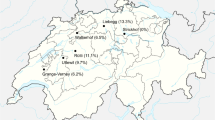Abstract
Potato virus Y (PVY) is one of the most, if not the most, economically important viruses of potato. This virus occurs worldwide wherever the crop is grown. Infections with PVY reduce both yield and quality of the potato crop. The virus occurs as numerous biological strains that differ in pathogenicity on potato and tobacco and vary considerably in their serological and molecular genetic characteristics. The purpose of this symposium is to provide up-to-date information on the characteristics of this important virus, details of its genetic make-up and variability, research efforts in North America, and Europe, and an outline of the workings of a potato virus seed certification effort.
Resumen
El virus Y de la papa (PVY) es uno de los más, si no el más, económicamente importante virus de la papa. Se presenta en todo el mundo en donde se siembra este cultivo. Las infecciones con PVY reducen tanto el rendimiento como la calidad del cultivo de la papa. El virus se presenta como numerosas variantes biológicas que difieren en patogenicidad en papa y tabaco, y varían considerablemente en sus características genéticas serológicas y moleculares. El propósito de este simposio es el de dar a conocer información actualizada sobre las características de este importante virus, detalles de su constitución genética y variabilidad, esfuerzos en investigación en Norteamérica, Asia y Europa, y una guía en los trabajos del esfuerzo sobre certificación de virus en semilla de papa.
Similar content being viewed by others
There are many factors that are capable of reducing the yield and/or quality of potato crops. Some of the most important of these are insect and nematode pests, and various diseases caused by bacteria, fungi, phytoplasmas, and viruses. Viruses in particular can be difficult to control in a potato crop since most of these pathogens are perpetuated though the seed tubers used for propagation. Therefore, understanding the nature of these pathogens and excluding them from the agronomic system, controlling vectors (most are transmitted by insects or nematodes), and a thorough understanding of their epidemiology is of paramount importance for reducing economic losses due to virus infections. One of the most important of the potato-infecting viruses is Potato virus Y (PVY). This virus occurs worldwide and causes considerable economic damage to the crop wherever it is grown. Worldwide, millions of hectares of potatoes are grown annually. Since PVY is transmitted efficiently in the field by several species of aphids, and the virus is usually present at some level in the seed tubers, the virus can quickly spread within a field and cause considerable damage. The situation is made even more complex by the presence of numerous biological strains of PVY that differ in symptoms in foliage and tubers, serological (antibody) reactivity, and sequence of the genomic RNA of this virus. In the last five decades or more, considerable effort has been directed towards understanding and control of Potato virus Y. Presentations by renowned researchers in this symposium will focus upon:
-
General characteristics of PVY
-
A detailed examination of the molecular makeup of PVY
-
Research efforts on PVY in Canada
-
Research into development of resistant potato germplasm in Poland
-
Certification efforts aimed at reducing the level of PVY in seed tubers
Author information
Authors and Affiliations
Corresponding author
Rights and permissions
About this article
Cite this article
Crosslin, J.M. Introduction to 2009 International Symposium on Potato Virus Y. Am. J. Potato Res. 90, 1 (2013). https://doi.org/10.1007/s12230-012-9283-y
Published:
Issue Date:
DOI: https://doi.org/10.1007/s12230-012-9283-y




